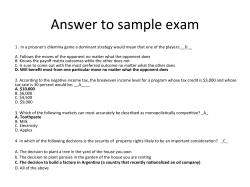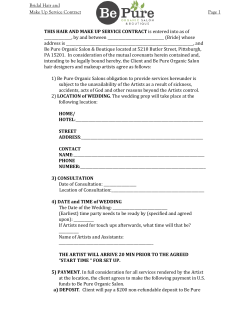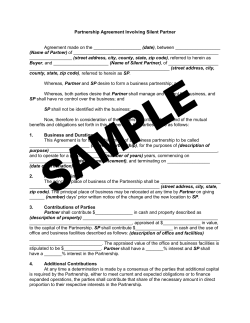
ANSWERS TO END-OF-CHAPTER QUESTIONS
Pure Monopoly ANSWERS TO END-OF-CHAPTER QUESTIONS 22-1 22-2 “No firm is completely sheltered from rivals; all firms compete for the consumer dollars. If that is so, then pure monopoly does not exist.” Do you agree? Explain. How might you use Chapter 18’s concept of cross elasticity of demand to judge whether monopoly exists? Though it is true that “all firms compete for the dollars of consumers,” it is playing on words to hold that pure monopoly does not exist. If you wish to send a first-class letter, it is the postal service or nothing. Of course, if the postal service raises its rate to $10 to get a letter across town in two days, you will use a courier, or the phone, or you will fax it. But within sensible limits, say a doubling of the postal rate, there is no alternative to the postal service at anything like it at a comparable price. The same case can be made concerning the pure monopoly enjoyed by the local electricity company in any town. If you wish electric lights, you have to deal with the single company. It is a pure monopoly in that regard, even though you can switch to oil or natural gas for heating. Of course, you can use oil, natural gas, or kerosene for lighting too—but these are hardly convenient options. The concept of cross elasticity of demand can be used to measure the presence of close substitutes for the product of a monopoly firm. If the cross elasticity of demand is greater than one, then the demand that the monopoly faces is elastic with respect to substitute products, and the firm has less control over its product price than if the cross elasticity of demand were inelastic. In other words, the monopoly faces competition from producers of substitute products. Discuss the major barriers to entry into an industry. Explain how each barrier can foster monopoly or oligopoly. Which barriers, if any, do you feel give rise to monopoly that is socially justifiable? Economies of scale are a barrier to entry because of the need for new firms to start big to achieve the low production costs of those already in the industry. However, not all industries need techniques of production that require large scale. In many industries the minimum efficient scale is only a small percentage of domestic consumption. Recall Chapter 20’s discussion on MES. Natural monopolies give rise to monopoly that is socially justifiable. The economies of scale are sometimes such that having two or more firms serving the market would increase costs unreasonably. Two telephone companies, or gas companies, or water companies, or electricity companies in the same city would be highly inconvenient and costly as long as transmission requires wires and pipes. In such instances, it makes sense for government to grant exclusive franchises and then regulate the resulting monopoly to ensure the public interest is protected. Patents and licenses are legal barriers to entry that also, to some extent, are justifiable. If inventions were not protected at all from immediate copying by those who bore none of the costs, the urge to invent and innovate would be lessened and the costly secrecy that is enforced already would have to be much greater and more costly. However, this does not mean that abuses do not exist in the present system and a case can be made for reducing the present seventeen years for which patents are granted. Ownership of essential raw materials is another barrier to entry. It has little social justification except to the extent that the hope of gaining a monopoly in the supply of an essential raw material leads to more prospecting. The Last Word on De Beers is an example. Unfair competition is the last of the barriers and has no social justification at all, which is why price-cutting to bankrupt a rival is illegal. The problem here, though, is to prove that cutthroat competition truly is what it appears to be. 333 Pure Monopoly 22-3 22-4 How does the demand curve faced by a purely monopolistic seller differ from that confronting a purely competitive firm? Why does it differ? Of what significance is the difference? Why is the pure monopolist’s demand curve not perfectly inelastic? The demand curve facing a pure monopolist is downward sloping; that facing the purely competitive firm is horizontal, perfectly elastic. This is so for the pure competitor because the firm faces a multitude of competitors, all producing perfect substitutes. In these circumstances, the purely competitive firm may sell all that it wishes at the equilibrium price, but it can sell nothing for even so little as one cent higher. The individual firm’s supply is so small a part of the total industry supply that it cannot affect the price. The monopolist, on the other hand, is the industry and therefore is faced by a normal downward sloping industry demand curve. Being the entire industry, the monopolist’s supply is big enough to affect prices. By decreasing output, the monopolist can force the price up. Increasing output will drive it down. Part of the demand curve facing a pure monopolist could be perfectly inelastic; if the monopolist put only a very few items on the market, it is possible the firm could sell them all at, say, $1, or $2, or $3. But it is the very fact that the monopolist could sell the same amount at higher and higher prices that would ensure that the profit-maximizing monopolist would not, in fact, sell in this perfectly inelastic range of the demand curve. Indeed, the monopolist would not sell in even the still slightly inelastic range of the demand curve. The reason is that so long as the demand curve is inelastic, MR must be negative, but since the MC of any item can hardly be negative also, the monopolist’s profit must decrease if it produces here. To equate a positive MR with MC, the monopolist must produce in the elastic range of its demand curve. (Key Question) Use the demand schedule that follows to calculate total revenue and marginal revenue at each quantity. Plot the demand, total-revenue, and marginal-revenue curves and explain the relationships between them. Explain why the marginal revenue of the fourth unit of output is $3.50, even though its price is $5.00. Use Chapter 18’s total-revenue test for price elasticity to designate the elastic and inelastic segments of your graphed demand curve. What generalization can you make regarding the relationship between marginal revenue and elasticity of demand? Suppose the marginal cost of successive units of output were zero. What output would the profit-seeking firm produce? Finally, use your analysis to explain why a monopolist would never produce in the inelastic region of demand. Price Quantity Demanded Price Quantity Demanded $7.00 6.50 6.00 5.50 5.00 0 1 2 3 4 $4.50 4.00 3.50 3.00 2.50 5 6 7 8 9 Total revenue, in order from Q = 0: 0; $6.50; $12.00; $16.50; $20.00; $22.50; $24.00; $24.50; $24.00; $22.50. Marginal revenue in order from Q = 1: $6.50; $5.50; $4.50; $3.50; $2.50; $1.50; $.50; -$1.50. See the accompanying graph. Because TR is increasing at a diminishing rate, MR is declining. When TR turns downward, MR becomes negative. Marginal revenue is below D because to sell an extra unit, the monopolist must lower the price on the marginal unit as well as on each of the preceding units sold. Four units sell for $5.00 each, but three of these four could have been sold for $5.50 had the monopolist been satisfied to sell only three. Having decided to 334 Pure Monopoly sell four, the monopolist had to lower the price of the first three from $5.50 to $5.00, sacrificing $.50 on each for a total of $1.50. This “loss” of $1.50 explains the difference between the $5.00 price obtained on the fourth unit of output and its marginal revenue of $3.50. Demand is elastic from P = $6.50 to P = $3.50, a range where TR is rising. The curve is of unitary elasticity at P = $3.50, where TR is at its maximum. The curve is inelastic from then on as the price continues to decrease and TR is falling. When MR is positive, demand is elastic. When MR is zero, demand is of unitary elasticity. When MR is negative, demand is inelastic. If MC is zero, the monopolist should produce 7 units where MR is also zero. It would never produce where demand is inelastic because MR is negative there while MC is positive. 22-5 (Key Question) Suppose a pure monopolist is faced with the demand schedule shown below and the same cost data as the competitive producer discussed in question 4 at the end of Chapter 21. Calculate the missing total- and marginal-revenue amounts, and determine the profit-maximizing price and profit-earning output for this monopolist. What is the monopolist’s profit? Verify your answer graphically and by comparing total revenue and total cost. Price $115 100 83 71 63 55 48 42 37 33 29 Quantity demanded 0 1 2 3 4 5 6 7 8 9 10 total revenue Marginal revenue $____ $____ $____ $____ $____ $____ $____ $____ $____ $____ $____ $____ $____ $____ $____ $____ $____ $____ $____ $____ $____ Total revenue data, top to bottom, in dollars: 0: 100; 166; 213; 252; 275; 288; 294; 296; 297; 290. Marginal revenue data, top to bottom, in dollars: 100; 66; 47; 39; 23; 13; 6; 2; 1; -7. Price = $63; output = 4; profit = $42 [= 4($63 - 52.50)]. Your graph should have the same general appearance as Figure 24-4. At Q =4, TR = $252 and TC = $210 [= 4($52.50)]. 335 Pure Monopoly 22-6 (Key Question) Suppose that a price discriminating monopolist has segregated its market into two groups of buyers, the first group described by the demand and revenue data that you developed for question 5. The demand and revenue data for the second group of buyers is shown in the accompanying table. Assume that MC is $13 in both markets and MC = ATC at all output levels. What price will the firm charge in each market? Based solely on these two prices, what can you conclude about the relative elasticities of demand in the two markets? What will be this monopolist’s total economic profit? Price Quantity demanded Total revenue $71 0 $0 Marginal revenue $63 63 1 63 47 55 2 110 34 48 3 144 24 42 4 168 17 37 5 185 13 33 6 198 5 29 7 203 Group 1 (from Question 5) will be sold 6 units at a price of $48; group 2 will buy 6 units at a price of $33. Based solely on the prices, it would appear that group 1’s demand is more inelastic than group 2’s demand. The monopolist’s total profit will be $330 ($210 from group 1 and $120 from group 2). 22-7 Assume that a pure monopolist and a purely competitive firm have the same unit costs. Contrast the two with respect to (a) price, (b) output, (c) profits, (d) allocation of resources, and (e) impact upon the distribution of income. Since both monopolists and competitive firms follow the MC = MR rule in maximizing profits, how do you account for the different results? Why might the costs of a purely competitive firm and a monopolist be different? What are the implications of such a cost difference? With the same costs, the pure monopolist will charge a higher price, have a smaller output, and have higher economic profits in both the short run and the long run than the pure competitor. As a matter of fact, the pure competitor will have no economic profits in the long run even though it might have some in the short run. Because the monopolist does not produce at the point of minimum ATC and does not equate price and MC, its allocation of resources is inferior to that of the pure competitor. Specifically, resources are underallocated to monopolistic industries. Since a pure monopolist is more likely than the pure competitor to make economic profits in the short 336 Pure Monopoly 22-8 run and is, moreover, the only one of the two able to make economic profits in the long run, the distribution of income is more unequal with monopoly than with pure competition. In pure competition, MR = P because the firm’s supply is so insignificant a part of industry supply that its output has no effect on price. It can sell all that it wishes to at the price established by demand and the total industry supply. The firm cannot force the price up by holding back part or all of its supply. The monopolist, on the other hand, is the industry. When it increases the quantity it produces, price drops. When it decreases the quantity it produces, price rises. In these circumstances, MR is always less than price for the monopolist; to sell more it must lower the price on all units, including those it could have sold at the higher price had it not put more on the market. When the monopolist equates MR and MC, it is not selling at that price: The monopolist’s selling price is on the demand curve, vertically above the point of intersection of MR and MC. Thus, the monopolist’s price will be higher than the pure competitor’s. Economies of scale may be such as to ensure that one large firm can produce at lower cost than a multitude of small firms. This is certainly the case with most public utilities. And in such industries as basic steel-making and car manufacturing, pure competition would involve a very high cost. On the other hand, monopolies may suffer from X-inefficiency, the inefficiency that a lack of competition allows. Monopolies may also incur nonproductive costs through “rent-seeking” expenditures. For example, they may try to influence legislation that protects their monopoly powers. The implications of the lower costs that economies of scale may give a monopolist are that a monopolist may not only produce at a lower cost than pure competitors but, in some cases, may also sell at a lower price. If such is the case, the misallocation of resources is reduced. Critically evaluate and explain: a. Because they can control product price, monopolists are always assured of profitable production by simply charging the highest price consumers will pay. b. The pure monopolist seeks the output that will yield the greatest per-unit profit. c. An excess of price over marginal cost is the market’s way of signaling the need for more production of a good. d. The more profitable a firm, the greater its monopoly power. e. The monopolist has a pricing policy; the competitive producer does not. f. With respect to resource allocation, the interests of the seller and of society coincide in a purely competitive market but conflict in a monopolized market. g. In a sense the monopolist makes a profit for not producing; the monopolist produces profits more than it does goods. (a) The statement is false. If the monopolist charged the highest price consumers would pay, it would sell precisely one unit! (Conceivably, it might sell a little more than one if more than one consumer made matching bids for the first unit offered.) It is highly unlikely that the sale of one unit (or a very few) would cover the very high AFC of one or a very few units. And even a monopolist that does produce sensibly where MR = MC may still suffer a loss: P can be below ATC at all levels. (b) The statement is false. The monopolist seeks the output that will yield the greatest profit. The profit equation is Q(P - ATC). It is not (P - ATC). If the monopolist sells one unit for $100 when ATC is $60, then its profit per unit and total profit is $40 (= $100 - $60). Nice, but if the same monopolist can sell 1,000 units for $40 when ATC is $39, then, though its per unit profit is a mere $1 (= $40 - $39), its total profit is $1,000 [= 1,000($40 - $39)]. This is much better than $40. 337 Pure Monopoly (c) The statement is true. Price is the value society sets on the last item produced. Marginal cost is the value to society of the alternative production forgone when the last item is produced. When P>MC, society is willing to pay more than the opportunity cost of the last item’s production. (d) This statement can be true and probably is in many cases. Large profits allow expansion to gain economies of scale and thus prevent the late entry of smaller rivals. Large profits also enable the firm to price below cost, to engage (illegally) in a price war. Moreover, large profits in the short run are often associated with monopoly power. In the long run, only a firm with monopoly power can gain economic profits; in pure competition such profits would invariably be competed away by new entry. (e) The statement is true. The monopolist must equate MR and MC. Having determined at what quantity this equality occurs, the monopolist simultaneously sets price. This price differs at each output because the demand curve is downsloping. The pure competitor accepts the price given by total industry supply and demand. Knowing this externally given price, the competitor then equates it with the firm’s MC and produces the amount determined by this equality. (f) The statement is true. In pure competition, P = MC. This means that the value society sets on the last item produced (its price) is equal to the cost of the alternative commodities that are not produced because of producing the last item of the commodity in question (its MC). In monopoly, P>MC. This means that society values the last item produced more than its cost. (g) The statement is true, “in a sense.” If the nondiscriminating monopolist produced where P = MC, it would be producing more at a lower price—and gaining a lower profit. By producing instead where MR = MC, the monopolist gains a greater profit by producing less where P>MC. However, the monopolist does produce goods and can produce at a loss. The statement really should be: “The monopolist does its best to produce profits by restricting the output of goods as much as necessary to ensure the equality of MR and MC.” Not as neat, but more accurate. 22-9 Assume a monopolistic publisher agrees to pay an author 15 percent of the total revenue from text sales. Will the author and the publisher want to charge the same price for the text? Explain. The publisher is a monopolist seeking to maximize profits. This will occur at the quantity of output where MC = MR. (See Key Graph 22.4) The author who will receive 15% of the total revenue will maximize his payment if the book is priced where MR = 0. This will occur where the price elasticity of demand is equal to 1 and total revenue is maximum. (See Figure 22.3) The author would prefer a lower price than the publisher. Consult Key Graph 22.4 and compare the price charged where MC = MR and the price that would be necessary to maximize total revenue when MR = 0. This is a highly unlikely outcome since the publisher, whether economically literate or not, is certain to recognize the revenue maximizing price as disadvantageous. 22-10 U.S. pharmaceutical companies charge different prices for prescription drugs to buyers in different nations, depending on elasticity of demand and government-imposed price ceilings. Explain why these companies, for profit reasons, oppose laws allowing reimportation of drugs to the United States. U.S. pharmaceutical companies are price discriminating based in part on the different elasticities of demand in different nations. Reimportation allows reselling of the goods, making it more difficult to price discriminate. To the extent they could still charge different prices, the difference in prices would have to be small enough so that reimportation was not profitable. Prohibition of reimportation would allow pharmaceutical companies to charge the profit-maximizing price in 338 Pure Monopoly each nation, without fear of being undercut back in the U.S. by those in nations where the drugs are cheaper. 22-11 Explain verbally and graphically how price (rate) regulation may improve the performance of monopolies. In your answer distinguish between (a) socially optimal (marginal-cost) pricing and (b) fair-return (average-total-cost) pricing. What is the “dilemma of regulation?” Monopolies that are natural monopolies are normally subject to regulation. Because of extensive economies of scale, marginal cost is less than average total cost throughout the range of output. An unregulated monopolist would produce at Qm when MC = MR and enjoy an economic profit. Society would be better off with a larger quantity. Output level Qr would be socially optimal because MC = Price and allocative efficiency would be achieved. However, the firm would lose money producing at Qr since ATC exceeds the price. In order for the firm to survive, public subsidies out of tax revenue would be necessary. Another option for regulators is to allow a fairreturn price that would allow the firm to break even economically (cover all costs including a normal profit). Setting price equal to ATC would deliver Qf output and only partially solve the underallocation of resources. Despite this dilemma regulation can improve on the results of monopoly from the social point of view. Price regulation (even at the fair-return price) can simultaneously reduce price, increase output, and reduce the economic profits of monopolies. 22-12 (Key Question) It has been proposed that natural monopolists should be allowed to determine their profit-maximizing outputs and prices and then government should tax their profits away and distribute them to consumers in proportion to their purchases from the monopoly. Is this proposal as socially desirable as requiring monopolists to equate price with marginal cost or average total cost? No, the proposal does not consider that the output of the natural monopolist would still be at the suboptimal level where P > MC. Too little would be produced and there would be an underallocation of resources. Theoretically, it would be more desirable to force the natural monopolist to charge a price equal to marginal cost and subsidize any losses. Even setting price equal to ATC would be an improvement over this proposal. This fair-return pricing would allow for a normal profit and ensure greater production than the proposal would. 22-13 (Last Word) How was De Beers able to control the world price of diamonds over the past several decades even though it produced only 50 percent of the diamonds? What factors ended its monopoly? What is its new strategy for earning economic profit, rather than just normal profit? De Beers produces 50 percent of all rough-cut diamonds, but buys a large portion of the diamonds produced by other mines. As a result, it marketed over 80 percent of the world’s diamonds. New diamonds were discovered and mined in Angola, Canada, and Australia and some of these diamonds were leaking into the world market. In addition, Russia was allowed to sell a portion of its diamond stock directly into the world market. 339 Pure Monopoly De Beers’ new strategy is to transform itself into a firm selling premium diamonds and other luxury goods. This new image will be portrayed in an advertising campaign. 340
© Copyright 2025


















